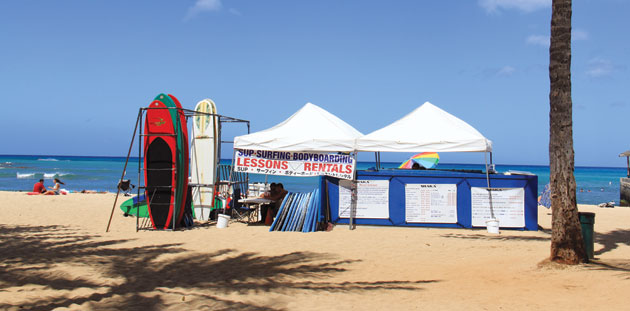Off the Beaten Path: Learning to Surf… For a Cause
Steven Pratt operates his non-profit water sports stand in Waikiki not far from the spot where he caught his first wave under the watchful eye of family friend and Natatorium lifeguard Steven Kauwili.
“I was five or six,” Pratt says. “I was on a board and the force of a wave was pushing me. I’m still just in awe of that experience.”
Pratt’s family named him after Kauwili and raised him near Kuhio Beach, where a bronze statue of Duke Paoa Kahanamoku, the most famous Waikiki Beach Boy of all time, now casts a shadow on the sand.
“The lifeguards were my uncles. They taught me the tradition of the beach boys and the importance of having a sense of respect for everyone that came … There once was a real relationship between the beach boys and the visitors,” he says.
The height of the original Waikiki Beach Boy movement was from the 1920s to the 1950s, when celebrated water sports instructors put Hawai’i tourism on the map.
Today the surf shacks are big business, but the city offers one stand to small non-profit interests that are dedicated to preserving the waterman lifestyle. Pratt’s stand, which supports the non-profit Shaka Foundation, strives to help kids from Hawai’i’s less fortunate families achieve their full potential.
“We help the visitors and they help us,” says Pratt, who opened his stand in February near the Kapahulu Groin, the walk-way that extends into the ocean from Queen’s Surf Beach and Kuhio Beach Park.
His stand is ideally located near the spot that locals call “Waikiki Walls,” which is perfect for beginners who want to try snorkeling, stand-up paddling or body boarding, says manager Derek Sala.

Shaka Foundation Stand at Waikiki Beach
Much like the beach boys of old, Pratt’s staff of 10 is dedicated to helping beginners find their stride. As modern-day beach boys, they are following in the footsteps of legends like Kahanamoku, who built Hawai’i tourism and sought to form authentic relationships with the state’s visitors.
“It’s important that we show visitors how to stay safe and have a good time in the water,” says 19-year-old beach boy Nicholas Kanakanui. “We want them to have a really good experience that they’ll remember forever.”
The visitors, in turn, are making new memories for locals by enabling Shaka Foundation to serve local kids. So far, the organization has given more than 100 local kids from financially strapped families the opportunity to find what Pratt calls their piko, the Hawaiian word for navel or center.
“I’m Hawaiian so I believe that a person’s piko should be made up of three things: family, religion and a talent for the thing that you were meant to do,” he said. “A person needs all three of these things to be a whole person.”
“Children need the chance to follow their hearts,” Pratt said. “I know this because I’ve been a coach all of my life and I’ve seen kids come and go. Many had talent, but their families couldn’t afford to have them keep going. They couldn’t get to the next level because they didn’t have the support. I’ve seen kids lose their self-confidence and turn to drugs or other forms of trouble.”
“Every kid deserves a chance,” Pratt said.
Did you know?
European and missionary influences nearly drowned out surfing in the 1800s—some viewed it as frivolous and immoral. However, the original Waikiki Beach Boys, who found their calling teaching water sports to visitors in the early days of Hawai’i tourism, restored pride to the surfing culture.
A three-time national award winning reporter, Allison Schaefers serves as the Waikiki Bureau Chief for the Honolulu Star-Advertiser. Based in Waikiki, she covers Hawaii tourism and Waikiki issues. Contact her at aschaefers@staradvertiser.com.









